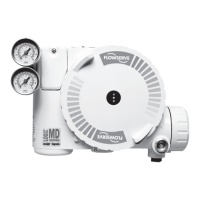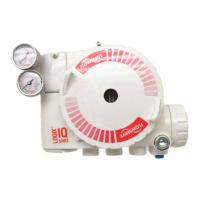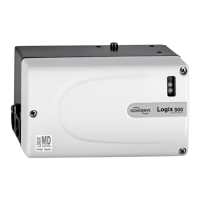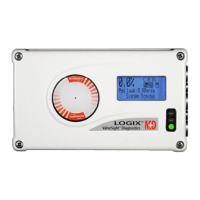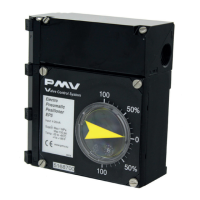29
Logix
®
420 Digital Positioner FCD LGENIM0106-07-AQ – 10/15
flowserve.com
increase sometime after this period. Reliability calculations based on
the data listed in the FMEDA report for lifetimes beyond 10 years may
yield results that are too optimistic, i.e. the calculated Safety Integrity
Level may not be achieved.
12.9 Proof Testing
The objective of proof testing when used in low demand mode of opera-
tion is to detect failures within the Flowserve 420 Valve Positioner and
its associated sensors and actuators that may not be detected by the
normal self-diagnostics. Of main concern are undetected failures that
prevent the safety instrumented function from performing its intended
function.
The frequency of the proof tests (or the proof test interval) is to be
determined in the reliability calculations for the safety instrumented
functions for which the Flowserve 420 valve positioner is applied. The
actual proof tests must be performed at least as frequently as specified
in the calculation in order to maintain required safety integrity of the
safety instrumented function.
The following tests need to be specifically executed when a proof test
is performed. The results of the proof test need to be documented
and this documentation should be part of a plant safety management
system. Positioner failures that are detected should be reported to
Flowserve.
To perform the proof testing, an LCD display or HART communicator
such as a 375 Handheld or software such as ValveSight DTM for Logix
420 are required.
Steps for Proof Test
1. Bypass the safety PLC or take other appropriate action to avoid
a false trip.
2. Set the trip output to the trip state (below 3.6mA) and ensure
that the attached valve is fully in the safe state (defined by
application) and has moved to that position within the allowed
time. This tests for failures that could prevent the closure of
the valve, including electronic and mechanical faults, as well as
valve faults.
3. Inspect the Logix 420 Digital Positioner for any visible damage
or contamination.
4. Remove the bypass from the safety PLC or otherwise restore
normal operation.
When the tests listed above are executed, a proof test coverage of 95%
can be claimed. Failure modes not covered include possible leaking of
the valve seat for fail closed valves.
Steps for Partial Valve Stroke Test
Step Action
1. Verify the control loop is ready for valve movement in the
amount set for the Partial Stroke Test (PST).
2. Excecute the PST via the LCD menu, DD, or DTM.
3. View the results of the PST via the LCD menu, DD, or DTM.
4. Check the errors generated by accessing the Alerts and Alarms
menu on the LCD menu, DD, or the Alarm Annunciator in the
DTM or other HART system using command 48.
When the tests listed above are executed, a partial valve stroke
coverage of 95% can be claimed. Failure modes not covered include
possible valve sticking in the travel range not tested and leaking of the
valve seat for fail closed valves.
12.10 Maintenance
Follow routine maintenance. See section 13.1 Scheduled
Maintainance.
12.11 Repair and replacement
In the unlikely event that the Flowserve 420 valve positioner fails, the
failure should be reported to Flowserve. Replace faulty components
according to section 8 MAINTENANCE AND REPAIR or return the
positioner to Flowserve for service. With experience and the right parts,
repair times for any component can be less than an hour, however a
24 hour mean time to repair should be assumed for safety availability
calculations.
12.12 Training Requirements
Activities specified in this manual shall be performed by a service
technician trained in the installation and maintenance of process
instrumentation. See section 1.4 QUALIFIED PERSONNEL.

